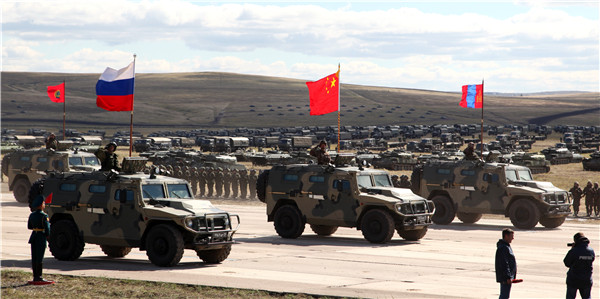


China, Russia and Mongolia conclude this week's "Vostok-2018" strategic drills with a military parade on Thursday at the Tsugol training range in Russia's Trans-Baikal region. PAN MENGQI/CHINA DAILY
China and Russia vowed to further deepen military ties and improve their troops' combat abilities to respond to various security threats, as they formally concluded the "Vostok-2018" strategic drills with a military parade on Thursday.
Russian President Vladimir Putin and Chinese State Councilor and Minister of National Defense Wei Fenghe inspected the troops at the Tsugol training range in Russia's Trans-Baikal region, where the exercise was held.
Wei said the drills reflect China and Russia's confidence and determination to jointly safeguard regional peace and security, and the exercise enhances the two militaries' ability to respond to multiple security threats.
The two sides should further strengthen their strategic cooperation and continuously promote the development of their military relations, Wei added.
Putin said in his opening speech before the parade that Russia will continue to enhance international military cooperation with other countries and strengthen its armed forces to counter different security threats.
He praised Russian and Chinese troops who participated in high-level drills in which they demonstrated their capability to counter potential military threats.
In the parade, the Russian army rolled out many of its latest and mightiest pieces of military hardware, including Iskander missiles, T-80 and T-90 tanks, and Su-34 and Su-35 fighter jets.
The People's Liberation Army displayed its Type-99 main battle tank, ZBD-08 infantry fighting vehicle, WZ-9 and WZ-19 attack helicopters, Mi-171 helicopters and the JH-7A fighter-bomber.

Russian President Vladimir Putin greets a Chinese soldier during the parade. ALEXEI NIKOLSKY/TASS
The drills, which began on Tuesday, were the largest of their kind in modern Russia's history and involved nearly 300,000 Russian troops.
China dispatched 3,200 soldiers, along with over 1,000 pieces of weaponry and 30 fixed-wing aircraft and helicopters to participate.
Shao Yuanming, vice-chief of staff at the Joint Staff Department of the Central Military Commission and Chinese chief commander at the drills, said the two militaries deepened their friendship, improved mutual trust and fostered cooperation. The exercises also enhanced the ability of both armies to respond to various regional security threats, he said.
The two nations will continue their military cooperation and explore new possible ways to boost their combat abilities, he said.
During three days of strategic drills, the troops simulated a classic anti-invasion campaign at the training range in eastern Siberia.
Beijing said the drills were not aimed at any third party.
Chinese troops' participation was reported to be their first large-scale overseas military activity since PLA military reforms started in 2016. It also marked the largest military event since Moscow's "New Look" army reform started in 2008.
The two militaries formed a joint operational command system during the drills. Li Weiya, a commander at the Chinese operational command headquarters, said the event has historical significance because it fully demonstrated the new cooperative form and level of the two armies.
He said China's participation shows Moscow and Beijing are now cooperating in all areas.
 Fire brigade in Shanghai holds group wedding
Fire brigade in Shanghai holds group wedding Tourists enjoy ice sculptures in Datan Town, north China
Tourists enjoy ice sculptures in Datan Town, north China Sunset scenery of Dayan Pagoda in Xi'an
Sunset scenery of Dayan Pagoda in Xi'an Tourists have fun at scenic spot in Nanlong Town, NW China
Tourists have fun at scenic spot in Nanlong Town, NW China Harbin attracts tourists by making best use of ice in winter
Harbin attracts tourists by making best use of ice in winter In pics: FIS Alpine Ski Women's World Cup Slalom
In pics: FIS Alpine Ski Women's World Cup Slalom Black-necked cranes rest at reservoir in Lhunzhub County, Lhasa
Black-necked cranes rest at reservoir in Lhunzhub County, Lhasa China's FAST telescope will be available to foreign scientists in April
China's FAST telescope will be available to foreign scientists in April "She power" plays indispensable role in poverty alleviation
"She power" plays indispensable role in poverty alleviation Top 10 world news events of People's Daily in 2020
Top 10 world news events of People's Daily in 2020 Top 10 China news events of People's Daily in 2020
Top 10 China news events of People's Daily in 2020 Top 10 media buzzwords of 2020
Top 10 media buzzwords of 2020 Year-ender:10 major tourism stories of 2020
Year-ender:10 major tourism stories of 2020 No interference in Venezuelan issues
No interference in Venezuelan issues
 Biz prepares for trade spat
Biz prepares for trade spat
 Broadcasting Continent
Broadcasting Continent Australia wins Chinese CEOs as US loses
Australia wins Chinese CEOs as US loses